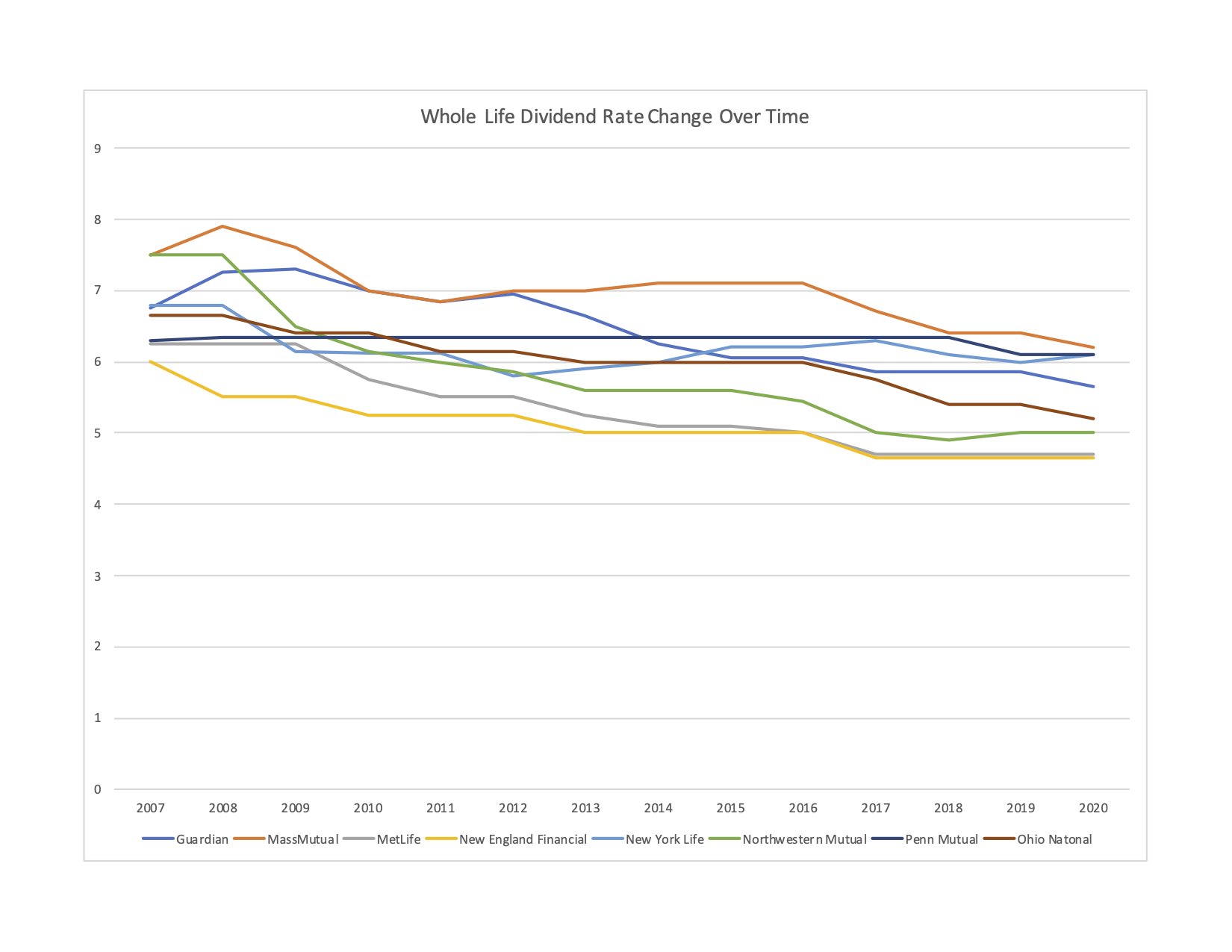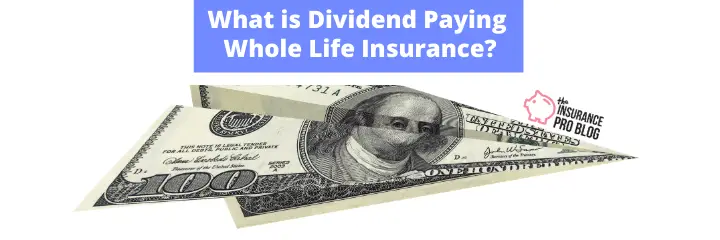As its name implies, dividend paying whole life insurance is a form of whole life insurance that earns a dividend from the insurance company that issues the policy. The official insurance term used to identify a dividend paying whole life policy is “participating” because the policy participates in the divisible surplus (i.e. profits) of the insurance company.
The alternative to a dividend paying whole life policy is a non-dividend (also called non-participating or non-par) paying whole life policies. These policies do not earn dividends and are generally issued for more specialized circumstances (e.g. burial or final expense policies or term conversions).
Life insurance dividends provide a lot of value that enhance various features of a whole life policy beyond the guaranteed features. Life insurance dividends also enjoy several tax favorable benefits.
Dividend paying whole life insurance is the type of life insurance necessary to implement a whole life plan that builds meaningful cash value and/or achieves an ever increasing death benefit.
How do Whole Life Dividends Work?
Each year the life insurer looks at its profits and the company's board of directors decides how much of these profits to pay to policyholders who own dividend paying policies. The company uses a formula to determine how much of the sum set aside to pay dividends will go to each individual policy. Once calculated, this dividend amount will go towards whatever dividend option the policy owner currently selected.
It's important to understand that while the dividend payment can grow over time, the forces that affect a rising dividend vary. This means the actual dividend payment may be more or less than the previous year's dividend payment. I bring this up because most life insurance ledgers that seek to explain policy functionality traditionally assume a scenario where dividend payments continuously increase. While this is possible, it's rarely the way things works out in real life.
How do Dividends Affect A Whole Life Policy's Cash Value?
Dividends can enhance a whole life policy's cash value through the paid-up additions dividend option. This option uses the dividend to purchase additional mini whole life policies that are immediately paid-up and have immediate cash value. These policies attach to your whole life policy and their death benefit and cash value adds to your whole life policy's death benefit and cash value.
Additionally, these paid-up additions can earn dividends so you are effectively compounding the growth of your whole life policy with this option. The Dividend purchases paid-up additions, which will earn more dividends. Those additional dividends will purchase even more paid-up additions, which in turn will go towards the purchase of even more paid-up additions.
How do Dividends Affect A Whole Life Policy's Death Benefit?
Dividends can affect the death benefit of a whole life policy in two ways.
First, the use of paid-up additions will also increase death benefit. For every $1 that goes towards a paid-up additions, you will achieve some multiple of death benefit (e.g. $1 used towards paid-up additions might create $3 in death benefit). The exact amount varies depending on the age of the insured of the policy. As we already covered, paid-up additions will compound because they themselves earn dividends in the future. This will cause your overall whole life death benefit to grow exponentially as time goes on.
Second, most whole life policies have a dividend option to purchase term life insurance. This uses the dividend payment to purchase term life insurance that adds to the gross death benefit of your whole life policy. This will certainly augment how much death benefit you achieve with your policy. Because it is term insurance, you should understand that his death benefit is not permanent. You should also understand that you would choose this option alternatively to paid-up additions, so you'll need to weigh which one gives you more of what you are seeking both now and in the future. This dividend option will do nothing for accumulating cash value in your whole life policy.
What Causes the Dividend Payment to Go Up?
There are two leading variable behind an increasing dividend payment from previous years. They are the policyholders use of the dividend within the whole life policy to earn more dividends in the future and the insurance company's ability to generate more profits in the subsequent year. This means some of this equation is well within the policy owner's control while other elements are outside of the policy owner's control.
Forces that cause the dividend to go up include the policy owners use of paid-up additions, the age of the whole life policy, and the insurers ability to generate increasing profits over the previous year.
What Causes the Dividend Payment to Go Down?
Again, the forces that cause a dividend to decline are partly up to the policy owner and partly up to the life insurance company. Examples that cause a dividend to go down include: the policy owners withdrawal of certain cash values from the policy, the trigger of a reduce paid-up nonforfeiture benefit, and the life insurers decline in profitability from one year to the next.
Can you Withdraw Dividends from a Whole Life Policy?
Yes you can withdraw dividends from a whole life policy. There are two primary ways you go about doing this.
First, you can use the dividend option to receive the dividend payment in cash. This will result in a direct payment of the dividend to you each year. The insurance company will pay you whatever the calculated dividend payable on your whole life policy is as a cash dividend sent as a check around the time of your policy anniversary.
The second option if you are using the paid-up additions dividend option, is to request a withdrawal from the policy (some companies will specifically call this a withdrawal of dividend additions). This results in a surrender of the paid-up additions purchased with dividends. This will result in a reduction of the overall death benefit on the policy (death benefit created by the paid-up additions you are withdrawing). You will then receive a check in the amount of the paid-up additions you requested to withdraw.
Are Whole Life Dividends Taxable?
Whole life dividends have several tax favorable features that make the payment of dividends largely non-taxable to you. In general, dividend are not taxable, but there are a few circumstances that could make them taxable.
First, if you are taking the dividend as a cash payment and you have receive a lifetime sum of dividend payments in excess of the total premiums you paid into the policy, that amount is taxable.
For example, assume that you own a whole life policy into which you paid a total of $50,000 in premiums. You opted to receive the dividend as a cash payment and beginning this year, the total dividends paid to you from inception of the policy equals $55,000. You will owe taxes on $5,000 in dividends and will now owe taxes on all future dividends received.
Second, if you opt to withdraw cash from your policy and you withdraw a sum in excess of the premiums you paid into the policy, you will owe taxes on the amount withdrawn above the sum of the premiums you paid.
For example assume the same scenario above where you have a whole life policy into which you paid $50,000 in premiums. Let's also assume that you have $110,000 in cash value in this policy. Also assume in this scenario that you used the dividend option to purchase paid-up additions in all years. You choose to withdraw $65,000 from the policy. You will owe taxes on $15,000 of this withdrawal because that is the difference between what you paid in premiums and what you removed from the policy. Also any subsequent withdrawals will be taxable unless you continue to make premium payments.
Historical Whole Life Dividend Chart
Whole life dividends can and do change over time. Here's a chart that maps out changes among various whole life companies over the past 14 years:
 Two major observations from this chart are 1.) whole life dividend rates tend to remain close across companies and 2.) some companies changed their dividend rate far more substantially over this time period than others. Keep in mind that the dividend rate is not a unified metric and one company's rate is not directly comparable to another. We can gain some insight from looking at the rate of change at one company to compare to another, but we cannot compare the absolute dividend rate value to another life insurance company.
Two major observations from this chart are 1.) whole life dividend rates tend to remain close across companies and 2.) some companies changed their dividend rate far more substantially over this time period than others. Keep in mind that the dividend rate is not a unified metric and one company's rate is not directly comparable to another. We can gain some insight from looking at the rate of change at one company to compare to another, but we cannot compare the absolute dividend rate value to another life insurance company.
The overall trend is a decline in dividend rates over this time period. This is not a surprise since interest rates in the broader U.S. economy trended down during this same time period. Life insurers invest heavily in interest sensitive investments, so lower overall interest rates, generally mean lower overall investment income for life insurers and this can influence profitability, which ultimately affects the dividend.

